2014 HYUNDAI COUPE warning
[x] Cancel search: warningPage 66 of 546
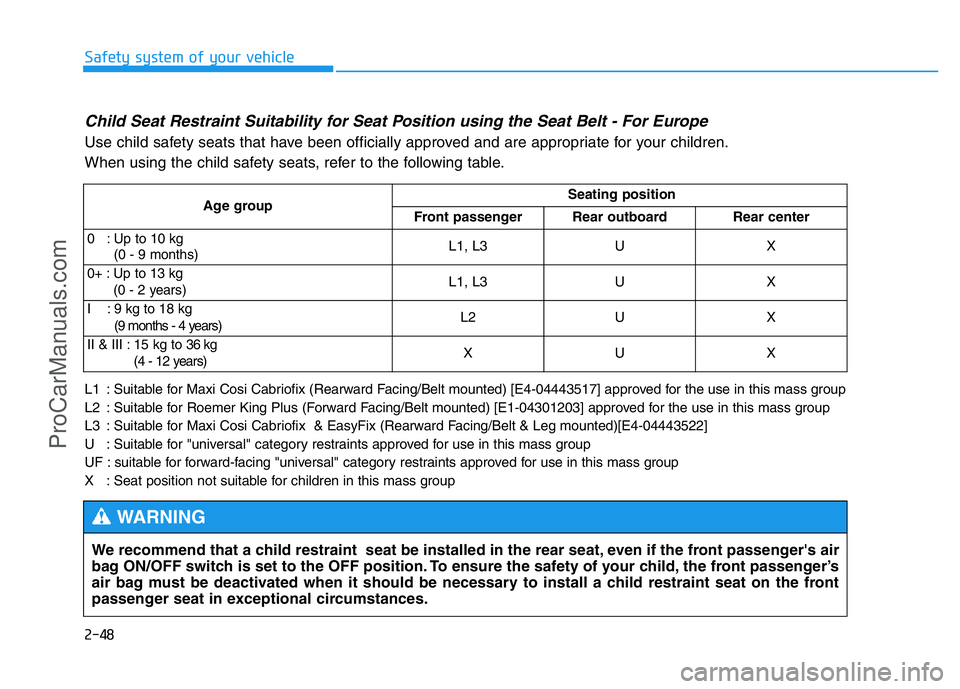
2-48
Safety system of your vehicle
Child Seat Restraint Suitability for Seat Position using the Seat Belt - For Europe
Use child safety seats that have been officially approved and are appropriate for your children.
When using the child safety seats, refer to the following table.
L1 : Suitable for Maxi Cosi Cabriofix (Rearward Facing/Belt mounted) [E4-04443517] approved for the use in this mass group
L2 : Suitable for Roemer King Plus (Forward Facing/Belt mounted) [E1-04301203] approved for the use in this mass group
L3 : Suitable for Maxi Cosi Cabriofix & EasyFix (Rearward Facing/Belt & Leg mounted)[E4-04443522]
U : Suitable for "universal" category restraints approved for use in this mass group
UF : suitable for forward-facing "universal" category restraints approved for use in this mass group
X : Seat position not suitable for children in this mass group
Age groupSeating position
Front passengerRear outboardRear center
0 : Up to 10 kg
(0 - 9 months)L1, L3UX
0+ : Up to 13 kg
(0 - 2 years)L1, L3UX
I : 9 kg to 18 kg
(9 months - 4 years)L2UX
II & III : 15 kg to 36 kg
(4 - 12 years)XUX
We recommend that a child restraint seat be installed in the rear seat, even if the front passenger's air
bag ON/OFF switch is set to the OFF position. To ensure the safety of your child, the front passenger’s
air bag must be deactivated when it should be necessary to install a child restraint seat on the front
passenger seat in exceptional circumstances.
WARNING
ProCarManuals.com
Page 68 of 546
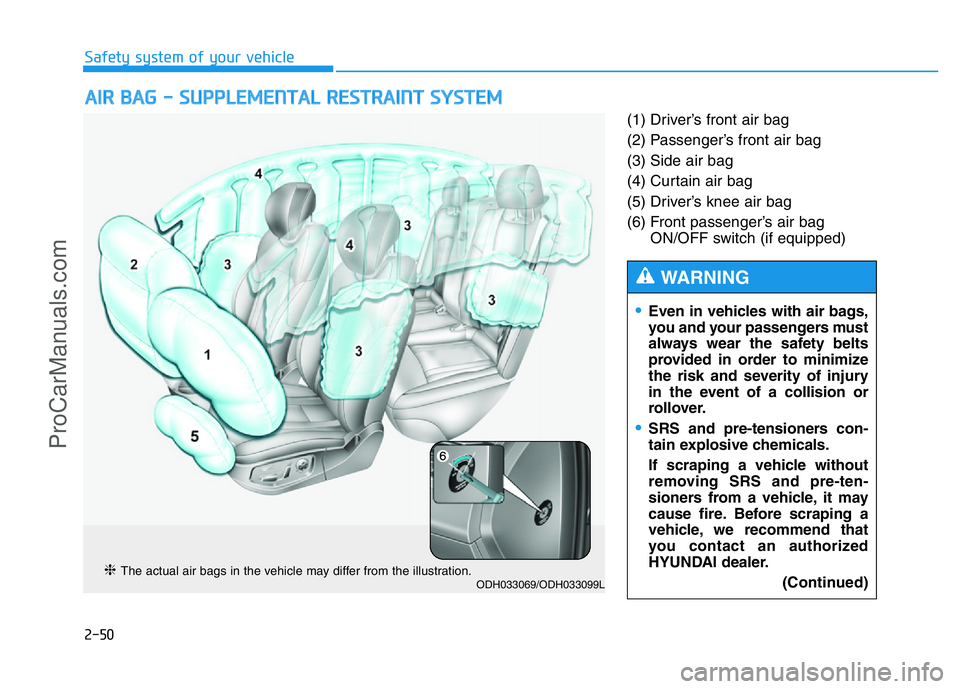
2-50
Safety system of your vehicle
(1) Driver’s front air bag
(2) Passenger’s front air bag
(3) Side air bag
(4) Curtain air bag
(5) Driver’s knee air bag
(6) Front passenger’s air bag
ON/OFF switch (if equipped)
AIR BAG - SUPPLEMENTAL RESTRAINT SYSTEM
ODH033069/ODH033099L❈ The actual air bags in the vehicle may differ from the illustration.
•Even in vehicles with air bags,
you and your passengers must
always wear the safety belts
provided in order to minimize
the risk and severity of injury
in the event of a collision or
rollover.
•SRS and pre-tensioners con-
tain explosive chemicals.
If scraping a vehicle without
removing SRS and pre-ten-
sioners from a vehicle, it may
cause fire. Before scraping a
vehicle, we recommend that
you contact an authorized
HYUNDAI dealer.
(Continued)
WARNING
ProCarManuals.com
Page 69 of 546
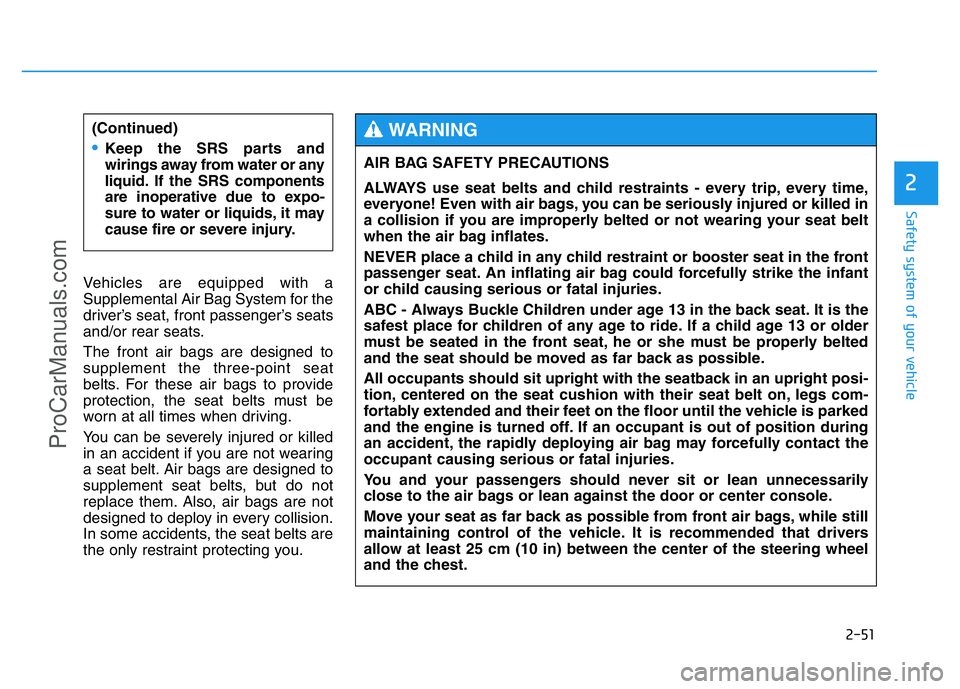
2-51
Safety system of your vehicle
2
Vehicles are equipped with a
Supplemental Air Bag System for the
driver’s seat, front passenger’s seats
and/or rear seats.
The front air bags are designed to
supplement the three-point seat
belts. For these air bags to provide
protection, the seat belts must be
worn at all times when driving.
You can be severely injured or killed
in an accident if you are not wearing
a seat belt. Air bags are designed to
supplement seat belts, but do not
replace them. Also, air bags are not
designed to deploy in every collision.
In some accidents, the seat belts are
the only restraint protecting you.AIR BAG SAFETY PRECAUTIONS
ALWAYS use seat belts and child restraints - every trip, every time,
everyone! Even with air bags, you can be seriously injured or killed in
a collision if you are improperly belted or not wearing your seat belt
when the air bag inflates.
NEVER place a child in any child restraint or booster seat in the front
passenger seat. An inflating air bag could forcefully strike the infant
or child causing serious or fatal injuries.
ABC - Always Buckle Children under age 13 in the back seat. It is the
safest place for children of any age to ride. If a child age 13 or older
must be seated in the front seat, he or she must be properly belted
and the seat should be moved as far back as possible.
All occupants should sit upright with the seatback in an upright posi-
tion, centered on the seat cushion with their seat belt on, legs com-
fortably extended and their feet on the floor until the vehicle is parked
and the engine is turned off. If an occupant is out of position during
an accident, the rapidly deploying air bag may forcefully contact the
occupant causing serious or fatal injuries.
You and your passengers should never sit or lean unnecessarily
close to the air bags or lean against the door or center console.
Move your seat as far back as possible from front air bags, while still
maintaining control of the vehicle. It is recommended that drivers
allow at least 25 cm (10 in) between the center of the steering wheel
and the chest.
WARNING (Continued)
•Keep the SRS parts and
wirings away from water or any
liquid. If the SRS components
are inoperative due to expo-
sure to water or liquids, it may
cause fire or severe injury.
ProCarManuals.com
Page 70 of 546
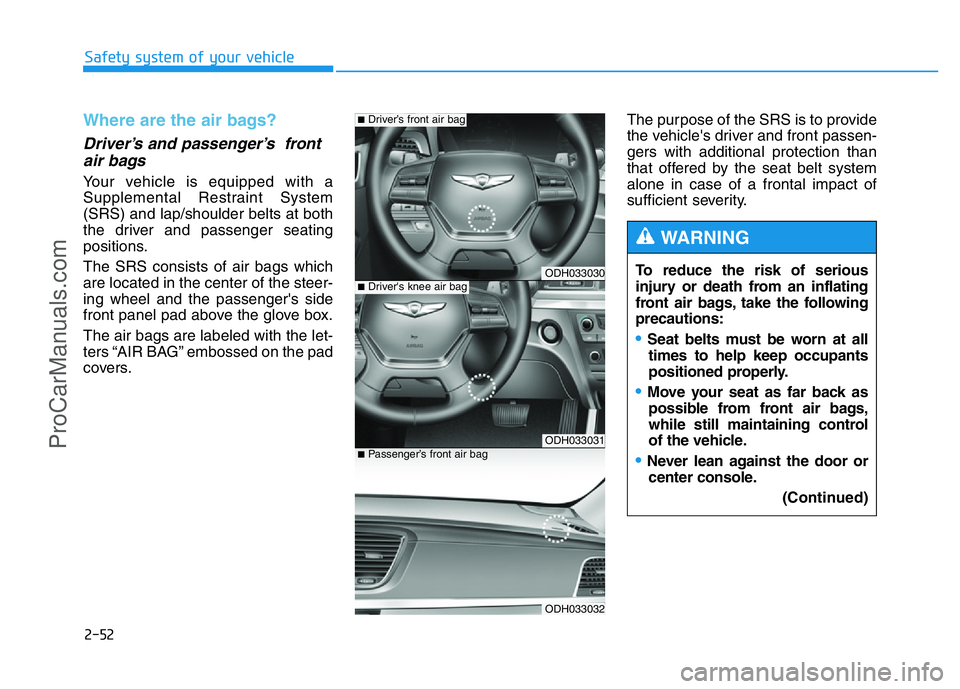
2-52
Safety system of your vehicle
Where are the air bags?
Driver’s and passenger’s front
air bags
Your vehicle is equipped with a
Supplemental Restraint System
(SRS) and lap/shoulder belts at both
the driver and passenger seating
positions.
The SRS consists of air bags which
are located in the center of the steer-
ing wheel and the passenger's side
front panel pad above the glove box.
The air bags are labeled with the let-
ters “AIR BAG” embossed on the pad
covers.The purpose of the SRS is to provide
the vehicle's driver and front passen-
gers with additional protection than
that offered by the seat belt system
alone in case of a frontal impact of
sufficient severity.
To reduce the risk of serious
injury or death from an inflating
front air bags, take the following
precautions:
•Seat belts must be worn at all
times to help keep occupants
positioned properly.
•Move your seat as far back as
possible from front air bags,
while still maintaining control
of the vehicle.
•Never lean against the door or
center console.
(Continued)
WARNING
ODH033030
ODH033031
ODH033032
■Driver's knee air bag
■Driver’s front air bag
■Passenger’s front air bag
ProCarManuals.com
Page 72 of 546
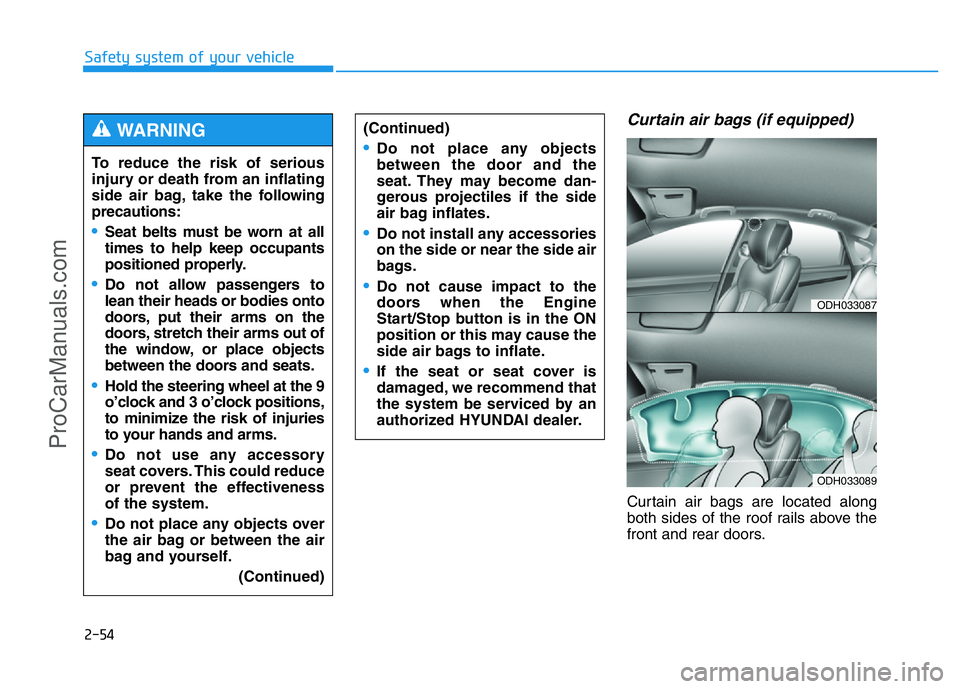
2-54
Safety system of your vehicle
Curtain air bags (if equipped)
Curtain air bags are located along
both sides of the roof rails above the
front and rear doors. To reduce the risk of serious
injury or death from an inflating
side air bag, take the following
precautions:
•Seat belts must be worn at all
times to help keep occupants
positioned properly.
•Do not allow passengers to
lean their heads or bodies onto
doors, put their arms on the
doors, stretch their arms out of
the window, or place objects
between the doors and seats.
•Hold the steering wheel at the 9
o’clock and 3 o’clock positions,
to minimize the risk of injuries
to your hands and arms.
•Do not use any accessory
seat covers. This could reduce
or prevent the effectiveness
of the system.
•Do not place any objects over
the air bag or between the air
bag and yourself.
(Continued)
WARNING (Continued)
•Do not place any objects
between the door and the
seat. They may become dan-
gerous projectiles if the side
air bag inflates.
•Do not install any accessories
on the side or near the side air
bags.
•Do not cause impact to the
doors when the Engine
Start/Stop button is in the ON
position or this may cause the
side air bags to inflate.
•If the seat or seat cover is
damaged, we recommend that
the system be serviced by an
authorized HYUNDAI dealer.
ODH033087
ODH033089
ProCarManuals.com
Page 73 of 546
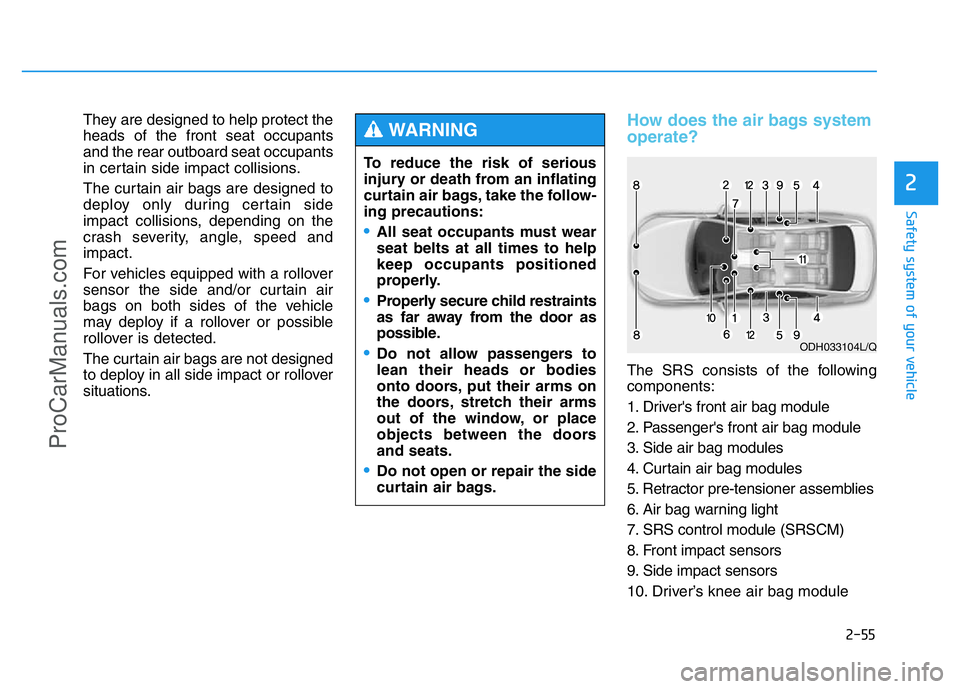
2-55
Safety system of your vehicle
2
Safety system of your vehicle
They are designed to help protect the
heads of the front seat occupants
and the rear outboard seat occupants
in certain side impact collisions.
The curtain air bags are designed to
deploy only during certain side
impact collisions, depending on the
crash severity, angle, speed and
impact.
For vehicles equipped with a rollover
sensor the side and/or curtain air
bags on both sides of the vehicle
may deploy if a rollover or possible
rollover is detected.
The curtain air bags are not designed
to deploy in all side impact or rollover
situations.How does the air bags system
operate?
The SRS consists of the following
components:
1. Driver's front air bag module
2. Passenger's front air bag module
3. Side air bag modules
4. Curtain air bag modules
5. Retractor pre-tensioner assemblies
6. Air bag warning light
7. SRS control module (SRSCM)
8. Front impact sensors
9. Side impact sensors
10. Driver’s knee air bag module To reduce the risk of serious
injury or death from an inflating
curtain air bags, take the follow-
ing precautions:
•All seat occupants must wear
seat belts at all times to help
keep occupants positioned
properly.
•Properly secure child restraints
as far away from the door as
possible.
•Do not allow passengers to
lean their heads or bodies
onto doors, put their arms on
the doors, stretch their arms
out of the window, or place
objects between the doors
and seats.
•Do not open or repair the side
curtain air bags.
WARNING
ODH033104L/Q
ProCarManuals.com
Page 74 of 546
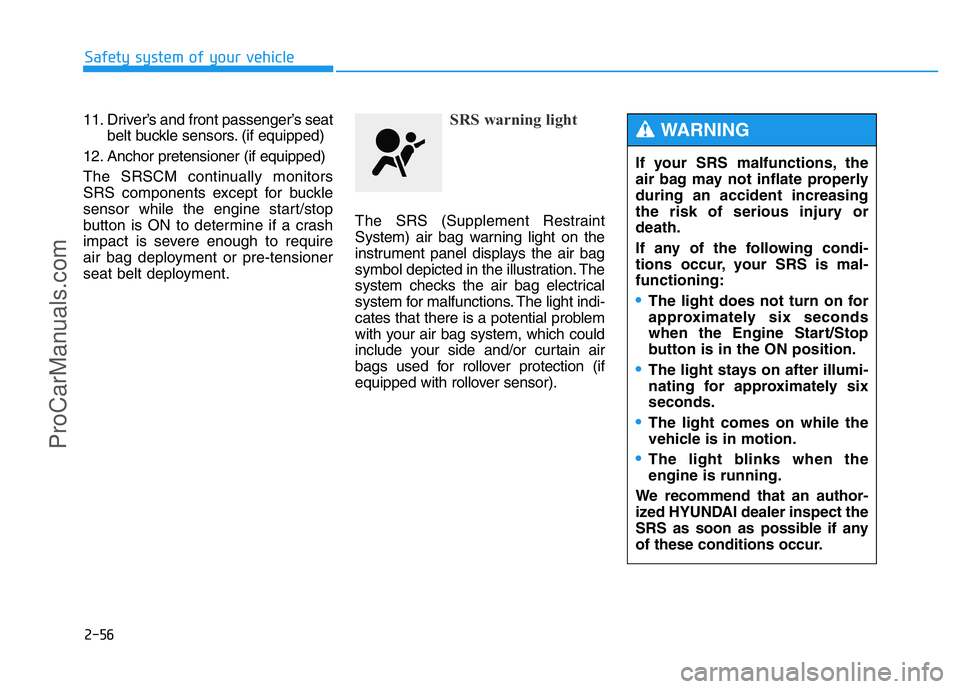
2-56
Safety system of your vehicle
11. Driver’s and front passenger’s seat
belt buckle sensors. (if equipped)
12. Anchor pretensioner (if equipped)
The SRSCM continually monitors
SRS components except for buckle
sensor while the engine start/stop
button is ON to determine if a crash
impact is severe enough to require
air bag deployment or pre-tensioner
seat belt deployment.
SRS warning light
The SRS (Supplement Restraint
System) air bag warning light on the
instrument panel displays the air bag
symbol depicted in the illustration. The
system checks the air bag electrical
system for malfunctions. The light indi-
cates that there is a potential problem
with your air bag system, which could
include your side and/or curtain air
bags used for rollover protection (if
equipped with rollover sensor).
If your SRS malfunctions, the
air bag may not inflate properly
during an accident increasing
the risk of serious injury or
death.
If any of the following condi-
tions occur, your SRS is mal-
functioning:
•The light does not turn on for
approximately six seconds
when the Engine Start/Stop
button is in the ON position.
•The light stays on after illumi-
nating for approximately six
seconds.
•The light comes on while the
vehicle is in motion.
•The light blinks when the
engine is running.
We recommend that an author-
ized HYUNDAI dealer inspect the
SRS as soon as possible if any
of these conditions occur.
WARNING
ProCarManuals.com
Page 77 of 546
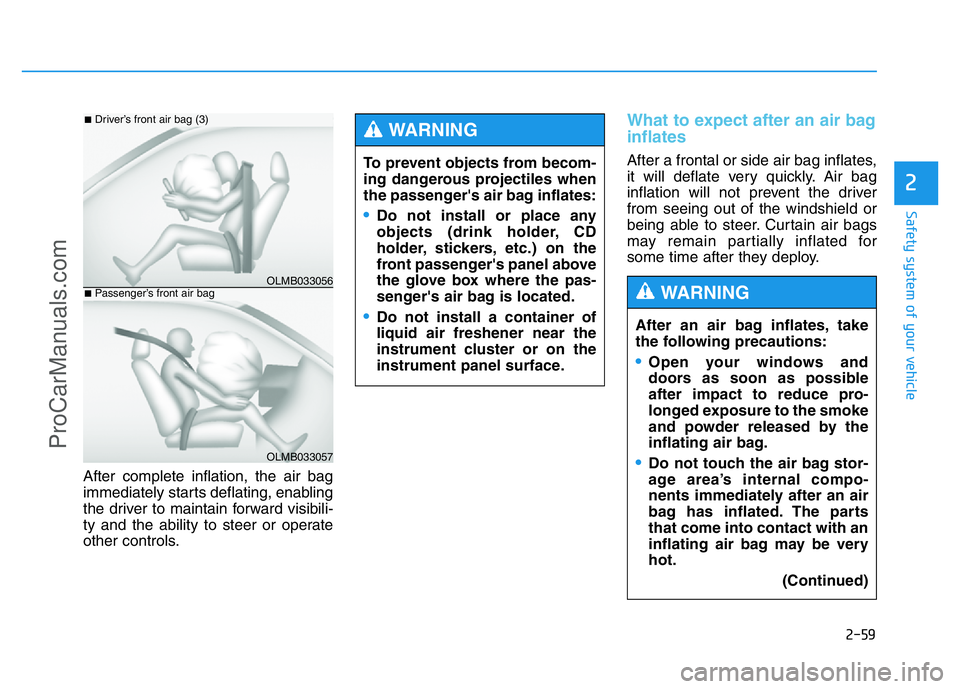
2-59
Safety system of your vehicle
2
After complete inflation, the air bag
immediately starts deflating, enabling
the driver to maintain forward visibili-
ty and the ability to steer or operate
other controls.
What to expect after an air bag
inflates
After a frontal or side air bag inflates,
it will deflate very quickly. Air bag
inflation will not prevent the driver
from seeing out of the windshield or
being able to steer. Curtain air bags
may remain partially inflated for
some time after they deploy.
OLMB033056
■Driver’s front air bag (3)
OLMB033057
■Passenger’s front air bag
To prevent objects from becom-
ing dangerous projectiles when
the passenger's air bag inflates:
•Do not install or place any
objects (drink holder, CD
holder, stickers, etc.) on the
front passenger's panel above
the glove box where the pas-
senger's air bag is located.
•Do not install a container of
liquid air freshener near the
instrument cluster or on the
instrument panel surface.
WARNING
After an air bag inflates, take
the following precautions:
•Open your windows and
doors as soon as possible
after impact to reduce pro-
longed exposure to the smoke
and powder released by the
inflating air bag.
•Do not touch the air bag stor-
age area’s internal compo-
nents immediately after an air
bag has inflated. The parts
that come into contact with an
inflating air bag may be very
hot.
(Continued)
WARNING
ProCarManuals.com